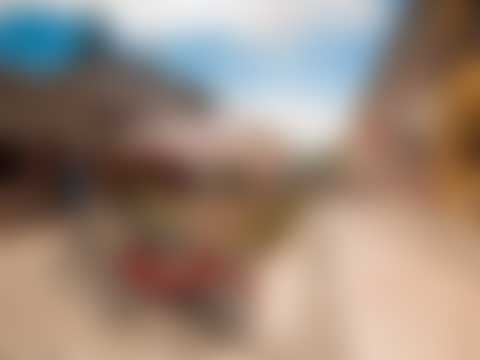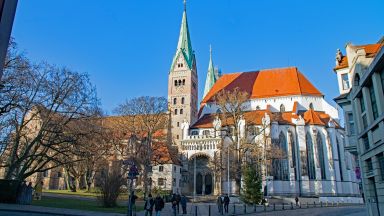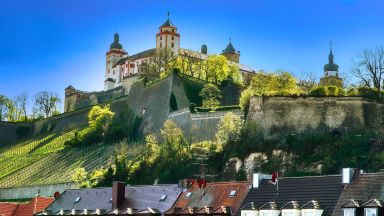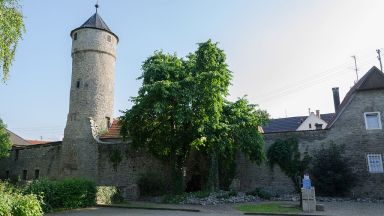Dinkelsbühl: The Complete Guide
Dinkelsbühl is an idyllic and quintessential Bavarian town, often visited by travelers on Germany’s renowned Romantic Road. This charming fortified city boasts a rich 800-year-old heritage and exudes an enchanting atmosphere, carefully maintaining its untouched medieval architecture and ambiance.Together with its neighboring towns, Rothenburg to the north and Nördlingen to the south, Dinkelsbühl stands as one of the few surviving walled medieval towns in Germany. The grand minster and the picturesque timbered buildings offer visitors a vivid glimpse into the captivating essence of the Middle Ages, allowing them to envision how these towns thrived during that era.
History of Dinkelsbühl
Dinkelsbühl occupied a crucial position at the crossroads of two significant trade routes: the Germany-Italy route running north to south, and the route connecting Rhine towns to Eastern Europe.
Believed to have been established in the 8th century, the town’s earliest documented mention (as “Tinkelspuhel”) dates back to the 12th century, when it already possessed the privilege of hosting a market.
During the 13th century, Dinkelsbühl became an Imperial free city and embarked on the construction of the fortifications that still encircle its historic center today.
The town’s prosperity flourished through weaving and cloth manufacturing, with the trading guilds spearheading efforts to expand their influence and secure privileges, such as membership in the town council.
Throughout the Middle Ages, Dinkelsbühl experienced the tumultuous religious conflicts of the Reformation and Counter-Reformation. Control over the town alternated between Protestant and Catholic authorities several times. Despite the majority of the population being Protestant, the 17th-century Concordance of Equality brought a settlement that ensured fair treatment for believers of both religions.
However, these wars, along with industrial and economic shifts in clothing production, led to a period of decline for the town. Consequently, many of the old town walls and buildings were preserved, as people lacked the financial means to construct new properties, which would have resulted in the demolition of older ones.
Another factor contributing to Dinkelsbühl’s current appearance was the decision by Ludwig I of Bavaria in the early 19th century to protect and safeguard the historic buildings from destruction.
The Kinderzeche festival, held annually in July, draws inspiration from the Thirty Years’ War. This children’s festival depicts the town’s rescue from Swedish mercenaries by the intervention of the gatekeeper’s daughter and the children of Dinkelsbühl. It also carries historical connections to the feasts and outings enjoyed by Catholic and Protestant schoolchildren at the end of the school year during the Middle Ages.
Visiting Dinkelsbühl for the first time and wondering what are the top places to see in the city? In this complete guide, I share the best things to do in Dinkelsbühl on the first visit. Top help you plan your trip, I have also included an interactive map and practical tips for visiting!
This website uses affiliate links which earn a small commission at no additional cost to you.
12 Best places to See in Dinkelsbühl
This complete guide to Dinkelsbühl not only tells you about the very best sights and tourist attractions for first-time visitors to the city but also provide insights into a few of our personal favorite things to do.
This is a practical guide to visiting the best places to see in Dinkelsbühl and is filled with tips and info that should answer all your questions!
Nördlingen Gate and Town Mill (Dinkelsbühl)

Location: Noerdlingen Gate Nördlinger Str. 62 91550 Dinkelsbühl Germany | Distance: 0.20km
Visiting Nördlingen Gate and Town Mill (Dinkelsbühl)
Wörnitz Gate, Dinkelsbühl
Location: Woernitz Gate, Altrathausplatz, Dinkelsbühl, Germany | Distance: 0.40km
Visiting Wörnitz Gate, Dinkelsbühl
House of History, Dinkelsbühl

Location: Haus der Geschichte Dinkelsbuhl Altrathauspl. 14 91550 Dinkelsbühl Germany | Distance: 0.40km
Visiting House of History, Dinkelsbühl
St. Georg (Dinkelsbuehl)

Location: St.-Georgs-Münster, Marktplatz, Dinkelsbühl, Germany | Distance: 0.50km
Visiting St. Georg (Dinkelsbuehl)
Weinmarkt, Dinkelsbühl

Location: Weinmarkt, Dinkelsbühl, Germany | Distance: 0.60km
Visiting Weinmarkt, Dinkelsbühl
Hospital of the Holy Spirit, Dinkelsbühl

Location: Dr.-Martin-Luther-Straße 8, 91550 Dinkelsbühl, Germany | Distance: 0.70km
Visiting Hospital of the Holy Spirit, Dinkelsbühl
New Town Hall, Dinkelsbühl

Location: Rathaus Segringer Str. 30 91550 Dinkelsbühl Germany | Distance: 0.70km
Visiting New Town Hall, Dinkelsbühl
Bäuerlin Tower

Location: Bauerlin Tower, Oberer Mauerweg, Dinkelsbühl, Germany | Distance: 0.70km
Visiting Bäuerlin Tower
Rothenburg Gate (Dinkelsbühl)

Location: Rothenburger Tor Dr.-Martin-Luther-Straße 12 91550 Dinkelsbühl Germany | Distance: 0.80km
Visiting Rothenburg Gate (Dinkelsbühl)
Armoury of the Dinkelsbühl 'Kinderzeche'

Location: Kinderzeche Dinkelsbühl - Historisches Kinder- und Heimatfest, Bauhofstraße, Dinkelsbühl, Germany | Distance: 0.80km
Visiting Armoury of the Dinkelsbühl 'Kinderzeche'
Three Kings Chapel, Dinkelsbühl

Location: Adlergäßlein 3, 91550 Dinkelsbühl, Germany | Distance: 0.90km
Visiting Three Kings Chapel, Dinkelsbühl
Segringer Tor

Location: Segringer Tor, Segringer Straße, Dinkelsbühl, Germany | Distance: 0.90km
Visiting Segringer Tor


